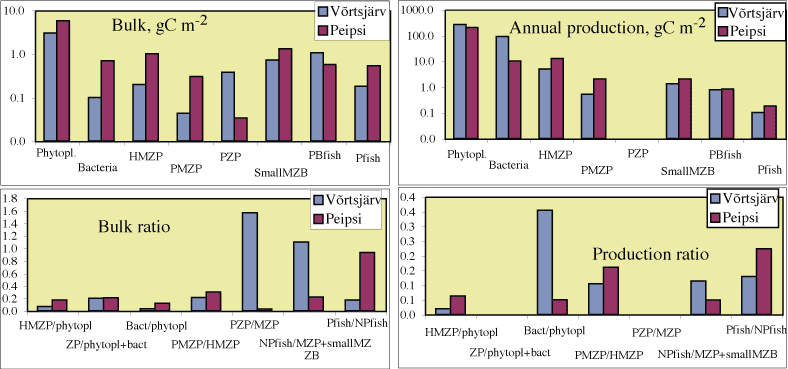


 |  |  | 21.8 Fishes and food webs |
Lake Peipsi is important for recreation and fishery in both neighbouring countries, Estonia and Russia. Considering its annual fish catches (9,000-12,000 tons or 25-34 kg ha-1) L. Peipsi exceeds all large lakes in North Europe. The main commercial fishes are lake smelt (Osmerus eperlanus eperlanus), perch (Perca fluviatilis), pikeperch (Sander lucioperca) and bream (Abramis brama), until the 1990s also vendace (Coregonus albula). The stock of vendace decreased sharply in the beginning of 1990s and has not recovered. This has been explained by the occurrence of unfavourable spawning conditions in several successive years while the impact of eutrophication can not be neglected either. At the same time, the abundance of pikeperch increased remarkably [371][260].
Lake Võrtsjärv was considered as a ruffe-lake in 1950s and 1960s as small non-valuable fishes, most of all ruffe Gymnocephalus cernuus dominated in catches. From late 1960s until early 1970s the fine-meshed trawling was stopped as it was considered to damage the commercially important piscivorous fish, first of all pikeperch. The introduction of glass eels was started to increase the commercial value of fish catches. As the result of these measures, the catches of pikeperch and other valuable fish increased rapidly. By now the value of catches has increased by 3-5 times while the total yearly catch has remained quite stable, 300-400 tons or 10-15 kg ha-1 [247].

In the food web of a lake large carnivoruos fishes like pike and pikeperch are top predators placed on the highest level of the food pyramide. The amount of fishes and their distribution between planktovores, benthivores and piscivores is determined by the functioning of the whole food chain. The potential productivity at all trophic levels is controlled bottom-up by nutrient/food supply. The `health' of a lake ecosystem is, however, rather determined by the efficiency of the transformation of the organic matter produced by algae through food chain towards top predators. The more efficient this transformation, the higher is the production of `good' piscivorous fish and the better water quality can be expected. In that sense the composition of fish community in L. Peipsi can be considered `good' and even improving after the increase of pikeperch since the beginning of the 1990s. The share of piscivores in the fish biomass and production has increased more than three times: from, accordingly, 18% and 4.5% in 1986 up to 48% and 18% by the turn of century (calculated by A. Järvalt from the data of [261]). However, sharp decrease of clean-water species like vendace may indicate the consequences of eutrophication and cannot be considered as a desirable change [260].
Aquatic food chains usually have four links in the pelagic community: `phytoplankton -> zooplankton -> planktivorous fish -> piscivorous fish'. The ecological efficiencies of energy flow from one trophic level to another is 5-20%, the widely accepted average being 10%. Besides pelagic food chains macrovegetation can be an important primary producer. A considerable amount of energy can also be channelled through benthic food webs in many lakes. In such systems zoobenthos plays the role of herbivores and serves as food source for bottom-feeding fish like bream, roach etc. In lake Peipsi aquatic macrophytes do not play an important role in primary production because strong wave action disturbs their extensive development in such a large lake. Benthic fauna, first of all the invader Dreissena polymorpha, is well developed and benthic food webs are important in L. Peipsi [468]. A direct relationship between zoo- and phytoplankton in the food chain has been considered to prevail in Lake Peipsi [330][329], based on the fact that the production of herbivorous zooplankton forms about 10% of phytoplankton production. It means that zooplankton feeds mostly on live algae, and the dominance of large forms in phytoplankton is the result of high grazing pressure on small algae. The role of the `detritus food chain' and microbial loop seems to be rather modest in L. Peipsi. This is confirmed also by the very small biomass of protozoan ciliates that participate in the microbial loop compared with the biomass of metazooplankton acting mainly in the grazing food chain (Figure 15). In Lake Võrtsjärv the effeciency of the grazing food chain is rather low -- the production of herbivores is about 40 times lower than the primary production and the majority of algal production is utilized through detrital food chain. Intensive bacterial production and high ciliate biomass reflect the great importance of the microbial loop (Figure 14, [328]). If to compare the ecosystems of these two large shallow lakes, the specific feature for L. Peipsi is the high ratio of herbivorous zooplankton to phytoplankton, and carnivorous to planktivorous fishes, both indicating an effectively functioning food web. In Lake Võrtsjärv the extremely high biomass of protozooplankton and the high ratio of bacterial to phytoplankton production at low bacterial biomass (Figure 15) indicate the important role of microbial loop in the food web of this lake.
 |  |  | 21.8 Fishes and food webs |